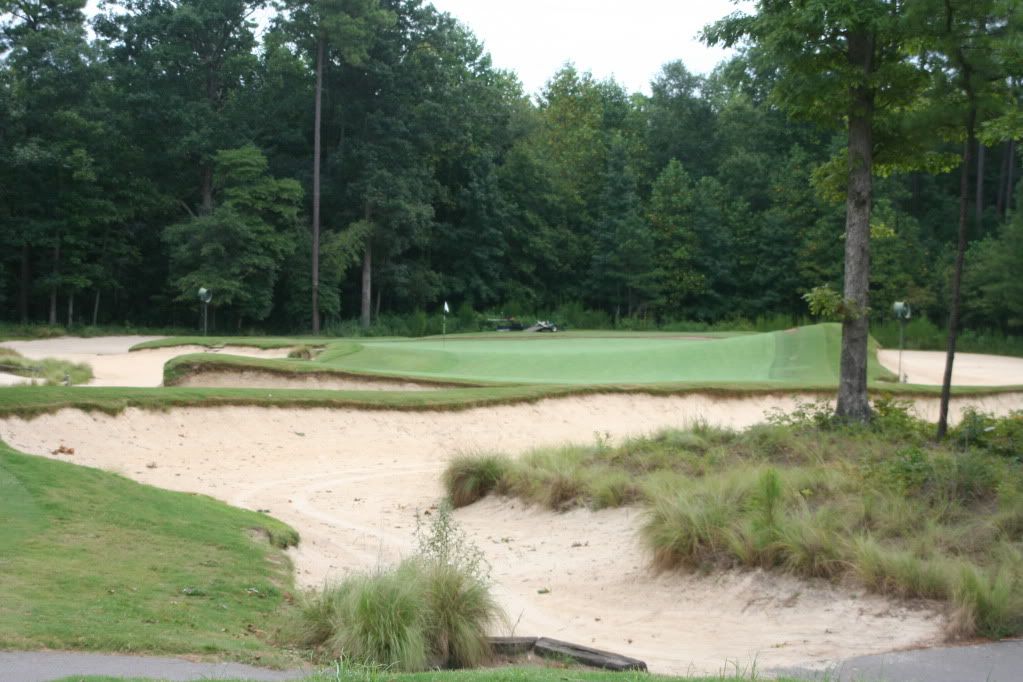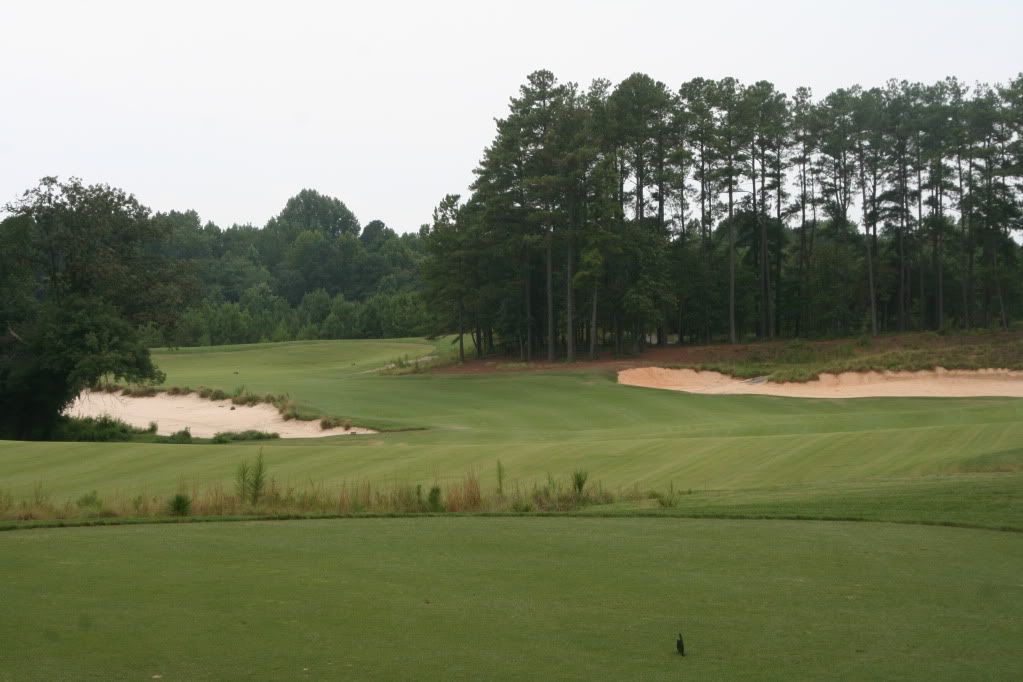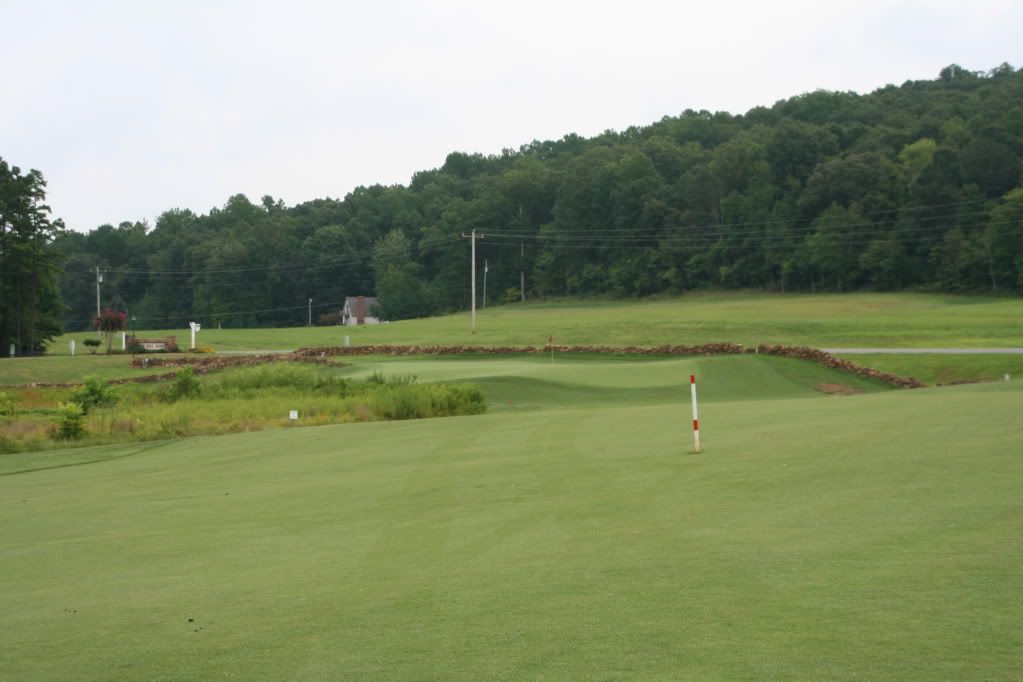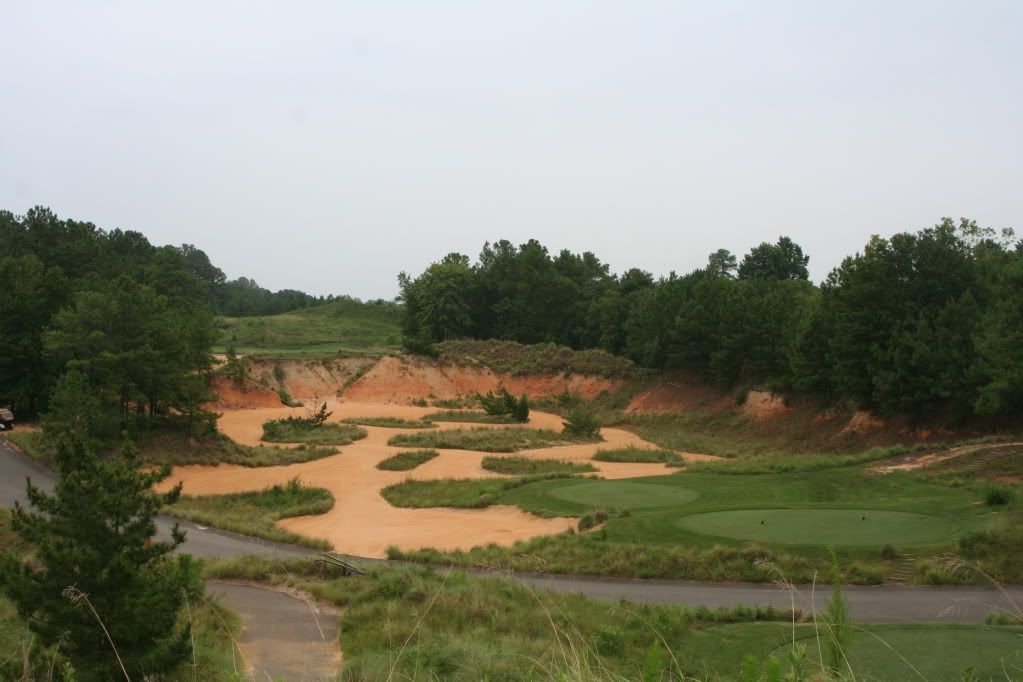Holes #10: Par 5, 519/503 yards
This is the only hole on the course that has a feature which can be considered somewhat unfair for lesser golfers but not in play for the better player, i.e. a bad feature. But that will be looked at in a moment. This hole is a generally straightforward par 5. As with many holes here at Peachtree, hole location will determine which side of the fairway is correct. In normal fashion, if the hole is cut front right, the left side of the fairway is preferred. From here the hole differs from the previous holes. Center hole locations are best approached from the right side of the fairway. The right side will yield a straight shot to the center of the green. However, holes cut in the far left portion of the green are very difficult to access with an aerial shot. For this hole location, either side of the fairway can be used, but the left side of the fairway will require the player hit a severe draw to the center of the green and let the fall roll down to the hole; the right side of the fairway will let the player hit a normal draw to the center of the green and, again, let it funnel back to the hole.
The above options are based on the golfer being able to go to the green in two shots and having to avoid the large bunker short of the green and the greenside bunker. The player laying up had better be able to pick a preferred yardage for the approach shot because the bottom of the flag will be obscured from the player and on left side locations, the entire flagstick may be out of view. The shot to the green will likely play two clubs uphill.
From the tee, the bottom of the fairway is blind to the player. The creek visible in the above aerial is not in play from the tee. The fairway is basically flat and the player will be able to aim down the correct side and not have to worry about the ball rolling into the rough.
From the left side of the fairway, the opening to the right side of the green can be seen. The difficulty in accessing a left hole location can be seen here; were the hole cut far left, the flat would actually be to the left of the clean-up stripe on the fairway.
The semi-unfair feature mentioned in the beginning is the creek that cuts through the fairway. This creek provides no hazard at all for better players. But for average players hitting 225 yards or so off the tee, the creek is a significant hazard in trying to get across. Perhaps this is how Mr. Jones intended the hole to be played in 1948, have distance off the tee determine if the player can carry the creek or not and have a short shot to the green. Either way, in the modern game, this feature provides a potentially large penalty to the average player and virtually no penalty to the better player. This is the only feature this writer would change on the course.
Hole #11: Par 3, 220/180 yards
This is a very simple, though long, par 3. There is the slight chance to roll the ball onto the green, but the slope in front of the green makes that difficult. Overall, on this hole, the player will simply be asked to pick a yardage, pick a target, and hit a shot. This is a good rest hole prior to the difficult stretch upcoming.
Playing through a valley, the roll-up option is there, though is would likely be a difficult shot to pull off in normal conditions.
Hole #12: Par 4, 486/431 yards
This is the longest par 4 on the course and may well be the best. This sharp dogleg must be played different ways depending on how long the player can hit his tee shot. The back tee is located at the single purple spot at the very bottom of the picture below. A 275 yard tee shot will wind up at the double purple dots; a 300 yard drive will end up at the two orange spots. As you can see, if the 275 yard player hits his shot up the right side of the fairway, his approach will be blocked out by the trees. This player must play to the center or left side of the fairway, leaving another 225+ yards to the center of the green. The 300 yard player can hit his tee shot down the far right of the fairway, cutting down to perhaps 175 yards to the green. However, both of these shots will play one club longer due to the approach being substantially uphill. On top of all this, the setting of the green is exceptional.
This shot taken from the 431 yard tee shows the blind tee shot down to the fairway. The downhill nature of the hole will help the player, but not greatly. If from the back tees, the 300 yard player could play directly down the right treeline, the 275 yard player will need to play directly over the tee boxes or slightly left of that.
Playing uphill to the green, the opening to the green is open enough to accept running shots, but the bunkers are there to provide penalty for shots hit off line. Players will need to take one extra club to get to the green.
Hole #13: Par 4, 470/385 yards
This is a solid and difficult par 4. Length off the tee is always a determining factor in how to play a given hole, but here it is key. Longer players, those that hit the ball out to 290 yards or more off the tee can play to any given point in the fairway and have a simple shot to the green with a middle iron. For these players, the bunkers in front of the green merely force them to guard against being short. Moderate length players, those hitting over 260 or so off the tee, have a different approach shot given that they will be playing from over 200 yards. These players should play up the left side so that they may use the kick-slope on the left side of the green in order to funnel the ball to the hole using ground contours.
This is a solid and difficult par 4. Length off the tee is always a determining factor in how to play a given hole, but here it is key. Longer players, those that hit the ball out to 290 yards or more off the tee can play to any given point in the fairway and have a simple shot to the green with a middle iron. For these players, the bunkers in front of the green merely force them to guard against being short. Moderate length players, those hitting over 260 or so off the tee, have a different approach shot given that they will be playing from over 200 yards. These players should play up the left side so that they may use the kick-slope on the left side of the green in order to funnel the ball to the hole using ground contours.
From the middle tee, the plays are simple. Down the treeline will leave the player with a shorter shot, up the left will give the best line if one is trying to use the kick-slope.
From the fairway, the kick-slope is visible on the left side of the green.
There is little to be said about this hole that can not be seen in the pictures. Hit the green, or very close to is, or you will likely be in the water or playing a bunker shot towards the water. Certainly this hole fits the bill for a Heroic Shot.
Hole #15: Par 4, 470/411 yards
This hole starts off a fantastic closing stretch. As seen before out here, hole location determines which side of the fairway is preferred. Left hole locations are best approached from the right side; right hole locations are best approached from the left side. The creek visible in the image below is possibly in reach from the tee for the longest players due to the significant slope downhill towards the creek.
The left to right slope of the fairway can be seen here. Hugging the treeline is necessary for those players wanting to hit in the left side of the fairway.
The cluster of players on the green marks the hole location here. The line from the left side of the fairway is clear, avoiding the bunkers. From the right side, the player would be forced to play over the greenside bunker.
Hole #15: Par 5, 577/510 yards
This is a solid par 5 that might be reachable for the longest players, but it right at the range that will have all the better players scratching their heads. The player must have in mind off the tee if he intends to go for the green in two shots. If so, the better play is up the right side of the fairway. If not, the play is the left side of the fairway. The left side of the fairway opens up the second fairway, across the creek, more to the player. The right side will give the player going for the green in two, or trying to get very close, a better angle around the two fronting bunkers.
This fairway slopes right to left off the same hill that slopes the 15th hole. Shots played to the right side of the fairway should be started near the treeline in order to stay on the right side.
From the left side of the fairway, roughly 240 yards from the green, the second fairway can be seen along with the small pond. The large bunker short of the green makes going for the green from this side of the fairway problematic.
This is the view from the right-center of the fairway, perhaps 175 yards from the green. This is roughly the angle that would be seen from 250+ yards out. From this angle, the bunkers can be more easily navigated, but the pond and secondary fairway angle would make the lay-up shot more difficult.
For one of the few times in the round, the best line of play off the tee is dictated to the player. The green angles away from the player left to right and has bunkers in front, making the preferred side of the fairway the left side. The left side will give the player a longer part of the green to work with and can also yield a run-up option for the player.
The fairway lays out nicely in front of the player. A play right towards the overhanging limbs of the pine tree will be perfect.
From the left side, the bunkers can be avoided and, although uphill, the player can attempt to roll the ball onto the putting surface if he wishes.
The final hole of the day is one of only three holes with a fairway bunker. However, unlike the bunkers on #1 and #9, the usefulness of this one is not clear. The left side of the fairway does not seem to yield a better line of approach to the green over the right side. As it stands now, the final hole comes in as a hole where the entire protection for the hole is at the green. The green has a huge fall off short and will cause balls to roll back 10-20 yards off the green. This is a great hole to close out the round, giving the player a great chance to close with birdie if he can hit two solid shots.
From the tee, the bunker sits there staring at the player. Typically, that means the preferred angle is near there, but in this situation, that does not appear to be the case.
From over the bunker, this approach awaits the player. The bottom of the flagstick is not visible to the player making the shot more difficult.
The front roll-off area is visible here.
Overall, this course is very, very good. The shot making requirements from start to finish are high but not to high as to keep the course from being fun for the average golfer. It might be noted by the reader that there was little mention of the greens. As a rule, the greens had great features, but not the kind that come out well in photographs. The features were small and sweeping with the majority of the green being sloped as opposed to modern greens where the slopes are huge and bold and the rest of the green is virtually flat. These are some of the finest greens this writer has seen. That coupled with the shot requirements and flow in the round yields a fantastic golf course. 8 out of 10









































